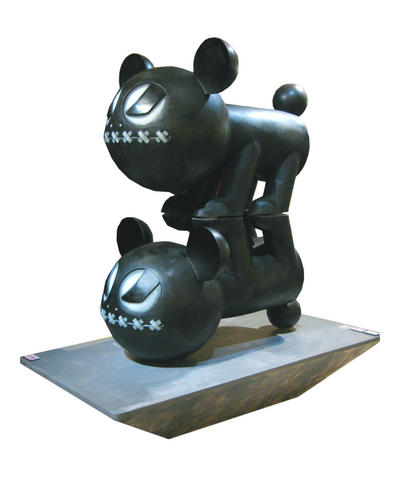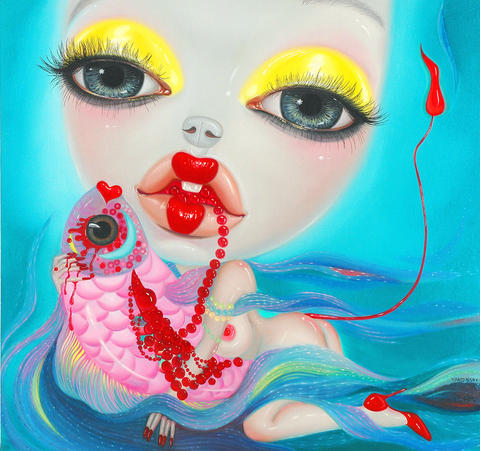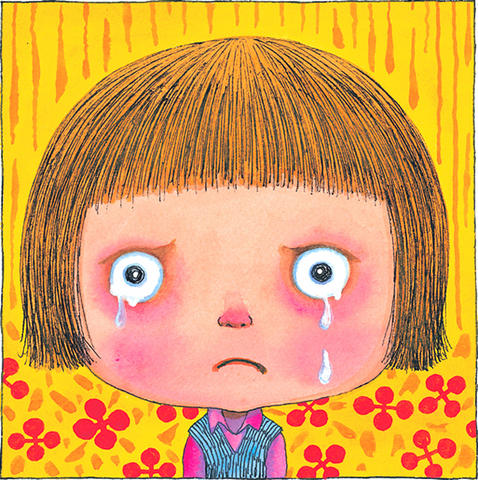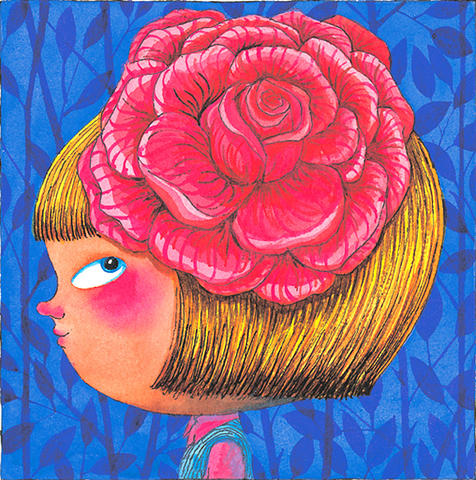Eddie Kang is obsessed with manga. An avid collector of the Japanese comics since he was a child, his creative world is dramatically influenced by animation and cartoons. But if you think that Kang is an otaku, a devotee of the geeky Japanese subculture of mostly men obsessed with anime, comic books and other forms of escapism, then think again.
With stylish hair, designer clothes and fluent English that betrays his eight years spent in the US - including four at the Rhode Island School of Design where he studied video, film and animation - the 27 year-old South Korean artist looks like he just walked off the set of a soap opera.
Kang is one of a new kind of Asian artist: computer savvy, working in pixels rather than pigment and using easy-to-understand visuals. He is one of 40 artists included in the animamix exhibit at the Sun Yat-sen Memorial Hall. "The most important thing I want to put in my work is storytelling," he said to the Taipei Times.

PHOTO: COURTESY OF METAPHYSICAL ART GALLERY
"Everyone has a desire to appreciate art, or visual language, but I think it's a matter of the form," he said. "If it's a form that people can easily understand, without reading a script, without reading my pre-sketched work, I think it's a form that communicates best with people."
Kang's ideas about art stand in stark contrast to the abstract styles in vogue during the 20th century, which produced works that left many confused over the meaning of a painting or sculpture.
That confusion was shared by many young Asian artists who were brought up on a diet of Japanese manga and anime. Their work has itself become an art movement called animamix.

PHOTO: COURTESY OF METAPHYSICAL ART GALLERY
Art critic and Shih Chien University professor Victoria Lu (陸蓉之) first coined the term animamix for a 2004 exhibit that she curated called Fiction.Love: Ultra New Visions in Contemporary Art at Taipei's Museum of Contemporary Art. She has since curated exhibits in Shanghai, Beijing and Singapore.
Lu says animamix art has four discernible characteristics: the worship of youth culture, images and objects that are rich in meaning, a new perspective on light influenced by computer technology and blurred distinctions between highbrow and lowbrow art into non-hierarchical art forms.
The last is particularly important because producing installations, paintings and sculptures that can be sold in the highbrow market are crucial to an artist's success.

PHOTO: COURTESY OF METAPHYSICAL ART GALLERY
"Fine artists can turn themselves into commercial artists if they want to," Kang said. "But [for] commercial artists it's really hard to develop their work into fine art. Andy Warhol is the exception to this rule."
Like Warhol, animamix artists take iconic images from popular culture, repackage them and sell them to the highest bidder. Takashi Murakami and Yoshitomo Nara are two examples. Murakami, with about 100 employees, recently sold a sculpture titled Mr Pointy to Christie's owner Francois Pinault for a reputed US$1.5 million, a testament to the growing popularity of his work on the international art market.
Unlike Warhol, however, animamix artists frequently mass-produce their works and market them as videos, mouse pads and more. Murakami has a whole line of plastic figurines that sell for about US$3. At the opening of the exhibition at the Sun Yat-sen Memorial Hall, South Korean artist Kwon Ki Soo was handing out rubber key chains and cell phone caddies of a character from his paintings.

PHOTO: COURTESY OF METAPHYSICAL ART GALLERY
Lu says that, though it remains a growing movement in the art market in Asia, animamix art still has had difficulty making inroads into the West.
"It is difficult to develop this kind of art in Europe or America because the [position of] modern … and conceptual art is too powerful. This is not so powerful a tradition in Asia," she said. Only with recent high-profile sales of Murakami's and Nara's art has that begun to change.
"[Dealers] now see Murakami [and] Nara selling well and are taking the artwork seriously. Before they thought [it was] childish. But for Asian countries, we … don't have the heavy modernist tradition weighing us down."
Ironically, Japan, the country that spawned animamix art and is getting the highest prices at the auction block is the country that has been least receptive to the art form. Hikaru Morioka, director of Gallery Unseal, says Japan's late arrival to the international art market coupled with a general lack of interest in local contemporary art has resulted in minimal interest in animamix compared to South Korea and China.
Contemporary art galleries in Japan always look to Europe or New York for artists, he said. This, however, has begun to change.
Four years ago there were practically no galleries in Tokyo dealing in Japanese contemporary art, he said. Today the number has grown to around 40 - though a figure Morioka still thinks is too low for such a large metropolitan center and the birthplace of manga and anime.
South Korea has a vibrant art scene due in part to a government law that makes it mandatory for most newly built buildings to devote a percentage of their budget to acquiring art. Hwaik Lee, who represents Kang, says the works in her gallery typically sell for between US$5,000 and US$50,000, with buyers coming from all over the world.
Morioka says collectors and dealers curious about China are stimulating interest. It's a sentiment echoed by Lu, though one she says has as much to do with the Japanese art market as it does with interest in China. "In Tokyo, the market is mostly for Japanese collectors. But Shanghai and Beijing will be a platform for all Asian art, not just Chinese art," Lu said, citing a group of Italian collectors who recently purchased Japanese works from galleries in China.
"There are many Korean galleries [with] branches in Beijing and Shanghai," she said. "Japan is following."
Animamix responds to and builds on previous movements. In this case, it builds on the formal ideas of modernism and escapes from the mystifying creations of abstract art. It also draws upon local pop culture.
"Animamix art will be as important for the 21st century as abstract art was for the 20th century," Lu said.
Be that as it may, for artists like Kang, it's simply representing what he sees around him in a style that is accessible to the public.

Exceptions to the rule are sometimes revealing. For a brief few years, there was an emerging ideological split between the Democratic Progressive Party (DPP) and Chinese Nationalist Party (KMT) that appeared to be pushing the DPP in a direction that would be considered more liberal, and the KMT more conservative. In the previous column, “The KMT-DPP’s bureaucrat-led developmental state” (Dec. 11, page 12), we examined how Taiwan’s democratic system developed, and how both the two main parties largely accepted a similar consensus on how Taiwan should be run domestically and did not split along the left-right lines more familiar in

This month the government ordered a one-year block of Xiaohongshu (小紅書) or Rednote, a Chinese social media platform with more than 3 million users in Taiwan. The government pointed to widespread fraud activity on the platform, along with cybersecurity failures. Officials said that they had reached out to the company and asked it to change. However, they received no response. The pro-China parties, the Chinese Nationalist Party (KMT) and Taiwan People’s Party (TPP), immediately swung into action, denouncing the ban as an attack on free speech. This “free speech” claim was then echoed by the People’s Republic of China (PRC),

As I finally slid into the warm embrace of the hot, clifftop pool, it was a serene moment of reflection. The sound of the river reflected off the cave walls, the white of our camping lights reflected off the dark, shimmering surface of the water, and I reflected on how fortunate I was to be here. After all, the beautiful walk through narrow canyons that had brought us here had been inaccessible for five years — and will be again soon. The day had started at the Huisun Forest Area (惠蓀林場), at the end of Nantou County Route 80, north and east

Specialty sandwiches loaded with the contents of an entire charcuterie board, overflowing with sauces, creams and all manner of creative add-ons, is perhaps one of the biggest global food trends of this year. From London to New York, lines form down the block for mortadella, burrata, pistachio and more stuffed between slices of fresh sourdough, rye or focaccia. To try the trend in Taipei, Munchies Mafia is for sure the spot — could this be the best sandwich in town? Carlos from Spain and Sergio from Mexico opened this spot just seven months ago. The two met working in the